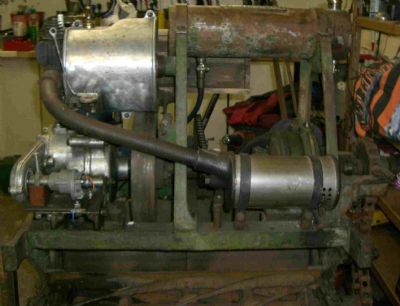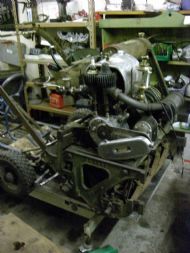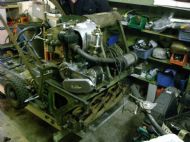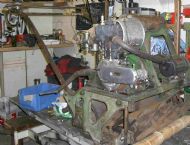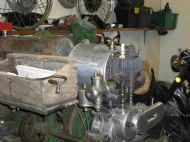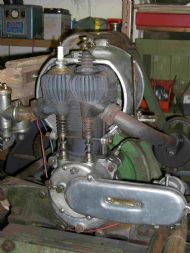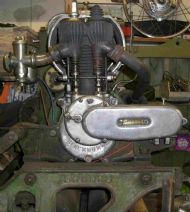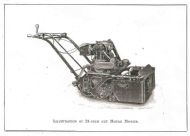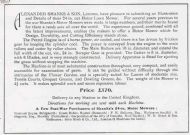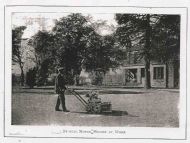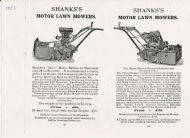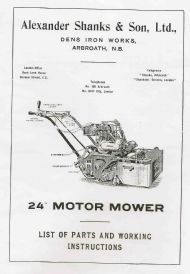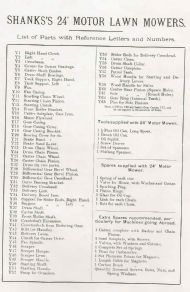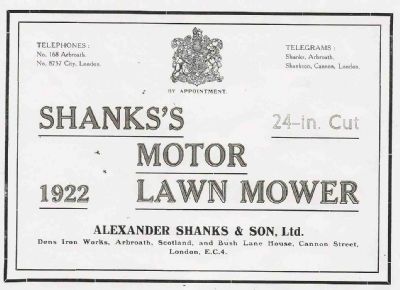 On Any Monday | sitemap | log in On Any Monday | sitemap | log in
|
 |
||
| This is a free Spanglefish 1 website. | ||
1922 (approx) Shanks Heavyweight Lawnmower
Front view of the Beast UPDATE 27th March 2011. We are indebted to Rick Parkington whose researching found our site. Rick has an interest in Blackburnes and was able to confirm our dating of the engine. The number E2457 Rick tells us is from the later production run of that engine type from probably 1921 or 1922 when Blackburne changed to the F design. Rick was able to give us a potted history of the Blackburne company and I can certainly confirm that I found it difficult to get any information on Blackburne other than what is generally known. The same could be said of the Shanks company which despite being well known mower manufacturers left little trace in the fossil record for us to piece together the company fortunes. I think we can leave the estimated date of manufacture of the beast as 1922. The design of the beast is such that any engine could be bolted into the chassis with appropriate engine mounting plates. It begs the question about just how many of these were made with the Blackburne engine if the mower had a run from 1921 to 1924 and the engine was discontinued as soon as the manufacture started. Did Shanks have a stock of Blackburne engines? Did they change to another suitable engine from 1922? It will be a rare beast whatever the answer! This fine piece of machinery was, as legend tells it, picked up from under a tree where it had lain for some decades, somewhere around Balkeerie in the 1970’s. It was transported to Rod's father's place where it was started up and them rested again under a tree for some more decades, until 2009 when it was brought to the shed. It was missing some parts, noticeably the grass box, the carburettor and the front roller. It also had many extra bits, mostly debris and a lot of rust. A hefty object, it took four of us to wrestle it onto the bench. It was powered by a Blackburne engine; Blackburne were a famous proprietary engine manufacturer that had produced it’s own motorcycles until the 1920’s and competed in the Isle of Man TT races with some success. The lawnmower itself was manufactured quite close by at Arbroath by Shanks. The large roller was split and we thought there would be a differential inside, and a large boss suggested that possibly a trailer with a seat for the operator to sit upon could be attached. The possible intended use was probably sports grounds, croquet lawns, tennis courts, bowling greens etc where a heavy roller and a close cut is required.
Two views of the mower - wheels are from a go-kart sitting behind
A visit to the museum at Arbroath confirmed that Shanks used to be a major manufacturer of lawnmowers, although long gone. Their mowers were high quality and large, photos in the museum showed them in use in sports grounds or large open spaces, with one photo depicting a V-twin engine of possibly 1000 cc and a trailer being used behind it. There was no information however on our specific mower and the records retained in the museum from Shanks were virtually non-existent and they had been taken over by a Midlands company before closing their factory in the 1970’s or 80’s. A trawl round the many lawnmower internet sites did not show our mower at all which was strange since a very comprehensive history of lawnmowers is available on the internet. The local museum had little and the well informed internet sites had nothing – were we dealing with a rare machine?
Front roller attached Toolbox and original carb The mower was rusty and in severe need of lubrication, so we started to renovate with our usual principles in mind – keep it as original as possible whilst getting it to work as it should. First the Blackburne engine was removed and turned upside down to empty the rainwater. It is a simple device, operating both side valves from a single camshaft. The piston has two rings – no scraper and low compression as you would expect. A measurement of bore and stroke gave a capacity of around 490cc, so we had a 500 cc Blackburne engine as a power source. The engine was actually in good condition and little wear was evident in any of the bearings; cleaned, oiled and assembled, it was ready to go fairly quickly. The rest of it would need to be figured out as we went!
500cc sidevalve engine
Exposed valvegear- note distributor The ignition system sadly was not so lucky and had reacted poorly to decades of water ingress. It would need money to repair and replace defective parts. In the meantime a battery and coil was rigged up to a Triumph Tiger Cub distributor for sparks. Unfortunately at this point the carburettor has not been uncovered and a petrol soaked cloth is used to provide the fuel delivery system! Anyway, the engine fires up and runs despite the rudimentary fuel system. A Mikuni is subsequently found and fitted in the meantime so at least we can get a laugh! The lawnmower is a sturdy machine with a cast iron frame and a complex chain drive for the roller and cutters operating through a clutch of sorts that is released by a band gripping on a cylinder that hides some gearing, as the output shaft rotates three times faster than the input and in the opposite direction.
Brochure picture and advertising blurb
The photos from Arbroath museum shows there is a lever missing which runs across the top of the handles. We assume that it might be a steering device but later we find out that this is in fact associated with the grassbox which is emptied by this lever without stopping the mower for any length of time. The whole grassbox / grass ejection system is entirely missing on our mower. We guess that it required maintenance and was removed for that reason or because the particular use did not require the grass to be collected. The photos also showed a similar mower with a second roller / trailer attached. We surmised that the trailer would be an optional extra, this is indeed the case as we discover later.
The Shanks Heavyweight in action
How he got it going!
Internet searches proceed apace and the best guess of the age is somewhere in the mid 1920's. The information that came with the mower is that it is 1927. Blackburne would probably produce this engine for many years after the end of WW1 and pictures of similar machinery suggest that around 1925 to 1927 would be correct. We have two more museum experiences in 2010 which reveals just what the mower is. Pete and Andy visit Sammy Miller's excellent museum in Hampshire. On display is a Blackburne engine exactly the same as the mower engine, and they don't know what it is! We provide them with what we have, which isn't much. Arbroath museum are having a revamp in mid 2010 and are able to access more of their collection of documents. They are able to tell us it is a heavyweight model and provide a users manual with parts diagrams that reveal the workings of the grassbox arrangement. It is also dated as somewhere between 1921 and 1924 which was the production run of this model. They also provide an advertising flyer from 1923 which mentions some of their clients for the mower, including a purchaser in nearby Murthly. The Shanks expert for the museum thinks it is particularly rare and we assume that this is most likely the same mower from Murthly quoted in the advertisements. If so it is likely to have been manufactured around 1921 to 1923.
A wide choice of big mowers
The 24 inch heavyweight details
Illustration of parts List of parts Happily the original carburettor is uncovered along with one of the original front rollers. The ignition arrangement does work quite well so we don't really bother about the magneto for the meantime. The rest of the mower is stripped, cleaned and lubricated. Of note is the split rear roller which does indeed have a differential inside to assist with steering the thing. There is a method of getting oil into the gears, and actually the whole machine is covered with lubricating points and grease nipples. The operating instructions state that it should be lubricated every HOUR! The engine is a total loss system from a sight glass which was found complete other than a broken tube inside which we managed to replace with a piece of brass tube cut and threaded as appropriate. Cooling is provided by a fan run off the flywheel through a rubber-tyred jockey wheel inside a cowling. The clutch was dismantled to reveal a sun and planet gear that was put back without any adjustment other than a wipe and re-greasing. When the drum is gripped, the drive is transmitted to the cutters and roller and when released, the drum is driven rather than the transmition. This is operated through a cable and handlebar lever. The original carburettor was cleaned up and works very well. It has a double handlebar control for choke and throttle for which cables and nipples had to be manufactured. A fiddly thing to assemble but once connected up has been fine in use. An additional starter charge of petrol can be placed directly into the cylinder from a small cup and tap. This can also act as a decompression device, and it has another decompression device in the shape of an exhaust valve lifter, both of which are unnecessary with the battery and coil ignition fitted. A front roller was made, with the five wooden rollers turned up by Andy's old man. These were too small and replaced with larger rollers when an original was discovered, again turned by Andy's old man. And so to the acid test – grass! It works perfectly! Hugely entertaining in use! Back to the 20's The Beast Runs Again!!! July 2011. The harsh winter has taken it's toll superficially on the mower. It hasn't run for many months, perhaps since September last year, and in the absence of anything meaningful to do, we drag it into the shed. The intention is to get it running and capable of cutting grass for the Glenisla Classic Vehicle Club Rally on 8th August. A bit of rubbing with an oily rag, dispelling any water and a freeing of cables soon has the old thing away again. The first attempt at start up is recorded on you tube here http://www.youtube.com/watch?v=DohVInsz7jE Remember it is 90 years old and ticks over like a sewing machine within seconds of being started! It doesn't get much better! |   |
|
 | ||
